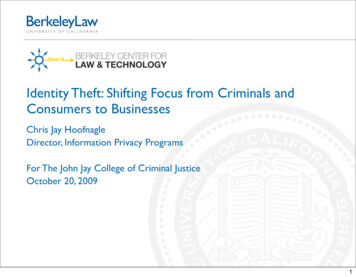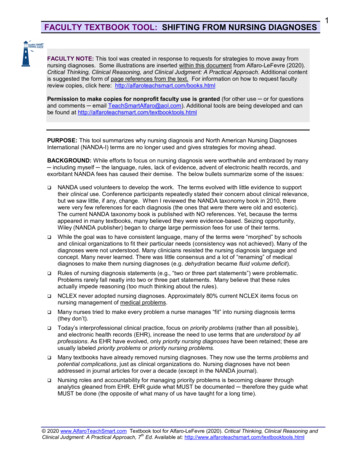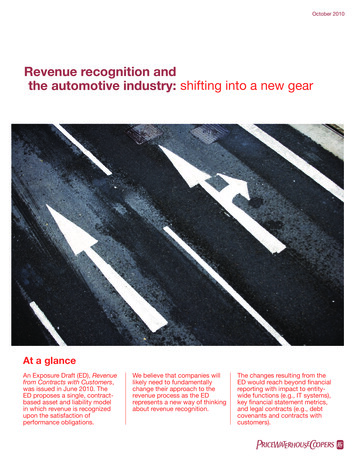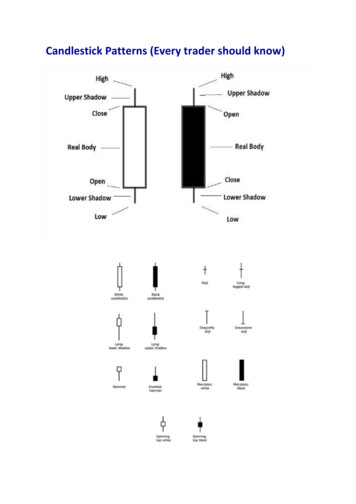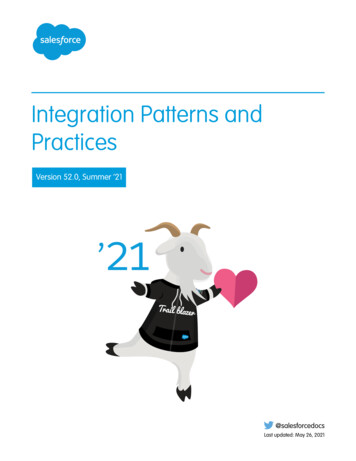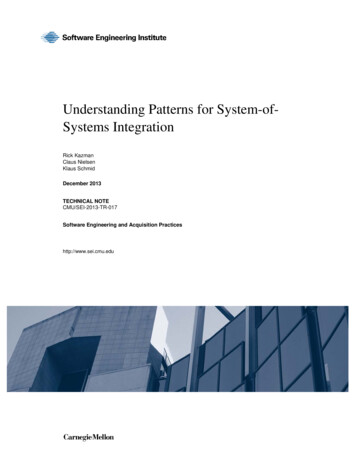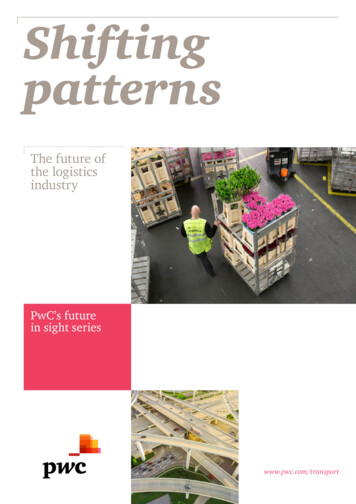
Transcription
ShiftingpatternsThe future ofthe logisticsindustryPwC’s futurein sight serieswww.pwc.com/transport
ContentsThe trick to seeing the future.is knowing where to look for it.PwC’s future in sight series bringstogether our insights and perspectiveson the disruptive forces we believewill have a transformative impacton the future.www.pwc.com/futureinsight2 Shifting patternsExecutive summary 2Introduction 3Disruption and uncertainty 5Changing customer expectations 5Technological breakthroughs 6New entrants to the industry 8Redefining collaboration 9Logistics scenarios 111. Sharing the PI(e) 122. Start-up, shake-up 133. Complex competition 144. Scale matters 15Leading through uncertainty 16Learn more 17
Executive summaryLike most other industries, transportation and logistics (T&L) iscurrently confronting immense change; and like all change, this bringsboth risk and opportunity. New technology, new market entrants, newcustomer expectations, and new business models. There are many waysthe sector could develop to meet these challenges, some evolutionary,others more revolutionary. In this paper we discuss four key areas ofdisruption logistics companies need to focus on now, and explore somepossible futures of the industry.Four areas of disruptionCustomer expectations are increasinggreatly. Both individuals and businessesexpect to get goods faster, more flexibly,and – in the case of consumers – at lowor no delivery cost. Manufacturing isbecoming more and more customised,which is good for customers but hardwork for the logistics industry. Add itall up and the sector is under acute andgrowing pressure to deliver a betterservice at an ever lower cost.It can only hope to do this by makingmaximum and intelligent use oftechnology, from data analytics, toautomation, to the ‘Physical Internet’.This promises lower costs, improvedefficiency, and the opportunity to makegenuine breakthroughs in the way theindustry works. But ‘digital fitness’is a challenge for the sector, which iscurrently lagging many of its customersin this respect. Attracting the right skillsis one issue, but developing the rightstrategy is even more crucial.An increasingly competitiveenvironment is another big factor in themix. Some of the sector’s own customersare starting up logistics operations oftheir own, and new entrants to theindustry are finding ways to carve outthe more lucrative elements of the valuechain by exploiting digital technology ornew ‘sharing’ business models, and theydon’t have asset-heavy balance sheets orcumbersome existing systems weighingthem down.‘Sharing’ is a big story for logisticsnow – from Uber-style approachesto last-mile delivery, to more formalJVs and partnerships at corporatelevel, the whole sector is redefiningcollaboration. But much of thisis hampered by inconsistenciesin everything like shipment sizes,processes or IT systems. The PhysicalInternet promises great things for thesector, coming along with increasedstandardisation in logistics operations.Possible futuresWhat will the logistics marketplace looklike in five to ten years? That’s still avery open question. We took a closerlook at how some of the key disruptionsfacing the industry may interact. Thefuture scenarios we explore involvecombinations of these four factors,weighted according to how importantspecific trends become:Sharing the PI(e): the dominanttheme in this scenario is the growth ofcollaborative working, which allows thecurrent market leaders to retain theirdominance. This could for example seea greater use of ‘Physical Internet’ (or‘PI’) solutions, based on a move towardsmore standardised shipment sizes,labelling and systems.Start-up, shake up: in this scenarionew entrants in the form of startups make a bigger impact. The mostchallenging and costly last mile ofdelivery, in particular, becomes morefragmented, exploiting new technologieslike platform and crowd-sharingsolutions. These start-ups collaboratewith incumbents and complement theirservice offers.Complex competition: here thecompetitive set evolves in a differentdirection, as large industrial or retailcustomers and suppliers become playersin the logistics market themselves, notjust managing their own logistics butturning that expertise into a profitablebusiness model.Scale matters: and finally, in thisscenario, the current market leaderscompete for a dominant market positionby acquiring smaller players, achievingscale through consolidation, andinnovation through the acquisition ofsmaller entrepreneurial start-ups.We hope this paper will help you assessthe trends and developments most likelyto affect your own business, and start todevelop a strategy to ensure continuedprofitability through this time of intensechange.The future of the logistics industry3
IntroductionLogistics companies are facing an era of unprecedented changeas digitisation takes hold and customer expectations evolve. Newtechnologies are enabling greater efficiency and more collaborativeoperating models; they’re also re-shaping the marketplace in ways thatare only just beginning to become apparent. New entrants, whether theybe start-ups or the industry’s own customers and suppliers, are alsoshaking up the sector.The race is on to define the industry’sfuture. And with an estimated US 4.6trillion1 of revenues at stake, companiescan’t afford to sit back and watch; theyneed to adapt to changing marketsproactively.We’ve developed a transformationframework to describe how megatrends2affect a given industry, taking intoaccount the key disrupting forcesthat create uncertainties for everyorganisation in the sector. Based onthese uncertainties, we outline distinctscenarios to explore possible futuresfor the sector. This framework will helpyou plan for this uncertain and volatilefuture.3For the logistics industry, we startby taking a closer look at some ofthe key disrupting factors: changingcustomer expectations, technologicalbreakthroughs, new entrants to theindustry, and new ways to competeor collaborate. These disruptionshave very different implications forindividual companies, depending onwhich segments they operate in, theirtype of ownership, and where theyare located. They also don’t exist in avacuum: in each case, the interactionsbetween them are equally, if not more,important. Government interventionand trade flows between regions andterritories are influencing the industrytoo, but very much depend on nationalpolitics and geography.1 search/Note: various estimates available, high variance, distinct approaches, difficult to measure given insourced and outsourced portions of the total market2 symposium/2014-megatrends-overview.pdf3 At PwC, we are analysing potential futures for various industry sectors and some papers are already published (see list on page 20).4 Shifting patterns
Defining ‘Logistics’ for this paperThere are a number of distinct business models in the industry, although they canoverlap, and individual companies may operate under more than one model. In thispaper, we consider logistics service providers (LSP), carriers, and courier / express /parcel (CEP) companies. Postal operators, too, are relevant players in the context oflogistics and CEP.Not only business models but profitability and margins differ considerably. Incontrast with other industries, profits in logistics are relatively low. Yet, within thissector, EBIT margins generally range from -1% to 8%. While carriers find themselvesclose to zero profit, sometimes even in the red, the large CEP companies end upbeing the most profitable group, sometimes reaching double-digit profit margins.4Customers in the logistics industry comprise of both B2B and B2C segments. Themajor part of the total market can be linked to B2B transactions, with LSPs andcarriers accounting for the biggest portion of industry revenue. CEP represents asmaller, but faster growing segment; and just about a third of CEP revenues can beattributed to B2C.SegmentB2BB2CBusinessModelCustomerLSPFreight forwarders, 3rd and 4th partylogistics service providersManufacturers,wholesalers, and retailersCarriersTrucking, rail freight, sea freight andair freight companiesLSPsCEPCourier / Express / Parcel companiesRetailers, manufacturers,and other companiesCEPCourier / Express / Parcel companiesPrivate consumersOur four logistics scenarios for thefuture of the industry are basedprimarily on the different wayscollaboration and competition couldevolve within the sector: Sharing the PI(e): the dominanttheme in this scenario is the growthof collaborative working, whichallows the current market leaders toretain their dominance. This couldfor example see a greater use of‘Physical Internet’ (or ‘PI’)5 solutions,based on a move towards morestandardised shipment sizes, labellingand systems. Start-up, shake up: in this scenarionew entrants in the form of startups make a bigger impact. The mostchallenging and costly ‘last mile’of delivery, in particular, becomesmore fragmented, exploiting newtechnologies like cloud platformsand crowd-sharing. These start-upscollaborate with incumbents andcomplement their service offers. Complex competition: here thecompetitive set evolves in a differentdirection, as large industrial or retailcustomers and suppliers becomeplayers in the logistics marketthemselves, not just managingtheir own logistics but turning thatexpertise into a profitable businessmodel. Scale matters: and finally, inthis scenario, the current marketleaders compete for a dominantmarket position by acquiring smallerplayers, achieving scale throughconsolidation, and innovationthrough the acquisition of smallerentrepreneurial start-ups.Together these logistics scenarios mapout a range of possibilities for thecontext in which every company willneed to compete in the future. Thatin turn provides a basis for evaluatinghow resilient and ‘fit for growth’ currentstrategies and plans are.Regardless of whether one logisticsscenario comes closest to the truthfor your segment of logistics andgeographical environment, or whetheryour future combines elements fromseveral, each company will need toadapt their current strategy to cope.That may mean reassessing businessmodels, the operating model andcapabilities, HR strategies, financialperformance, and the organisation’spurpose. We suggest some possibledirections in our final chapter. Moredetailed views on particular regions,segments and capabilities are still tocome in later articles.4 Strategy& analysis (peer groups of listed companies in each segment; average EBIT margins of the past 5 financial years)5 The term ‘PI(e)’ is here built into the phrase ‘Sharing the pie’, but also alludes to the Physical Internet, often referred to as ‘PI’; for more detail see page 9The future of the logistics industry5
Disruption and uncertaintyChanging customerexpectationsLike individual consumers,industrial customers nowexpect to get shipments faster,more flexibly, and with moretransparency at a lower price.No surprise that across theindustry, both operatingmodels and profitability areunder strain. And the paceof transformation for largemanufacturing and retailcustomers may turn out to beeven faster than for privatefinal consumers.B2B: Striving for efficiency andtransparencyManufacturing industries are facing fargreater expectations around efficiencyand performance than ever before. Theircustomers expect faster time-to-market,reduced defect rates and customisedproducts. Ultimately, the result maybe a goal that was once impossible: a‘lot size of one’, where each product ismanufactured to the specifications of aspecific end-customer. The advent of theindustrial Internet of Things and whatother research refers to as ‘Industry 4.0’is allowing manufacturing companies,whether they make industrialequipment, cars, planes, or consumergoods, to redefine everything from theway they interact with customers to howthey structure supply chains.67All this has huge implications fortransportation and logistics. LSPs – inparticular 3PLs and 4PLs – need tointegrate data analytics and socialsupply chains to provide muchbetter traceability and predictability(not to mention lower costs); smartwarehousing solutions will becomeessential. The implications are clear:‘digital fitness’ is becoming a must forevery logistics company.B2C: New shopping patternsMany logistics companies also serve B2Ccustomers. Consumers went digital longbefore many of the retailers, and someparts of the sector are still strugglingto keep up. The leading players areadopting what we call ‘total retail’,which is an operating model acrossbricks and mortar, online mobile andother retail channels.6 Total retail iscomplemented by ‘connected retail’,where retailers aim to create a seamlessbrand experience for the customeracross personalised marketing, thephysical store, the digital experience,and the payment options, all of it drivenby a strong coherent brand.7 Whatare the consequences for the C, Connected Retail: Reshaping tomorrow’s operating model and metrics, 20156 Shifting patternsShippers aren’t generally part of abranded retail experience. Most privateend-consumers are what we call‘shipper-agnostic’: they don’t care whodelivers their goods, as long as theyget them reliably, quickly and cheaply.Many want more flexible delivery –whether in terms of when or wherethey get their goods - and most aren’twilling to pay for shipping: they expectit to be free, though they are prepared topay a premium for additional services,such as faster delivery for high-valueitems. There’s also currently a lowacceptance of dynamic pricing forparcels; customers expect to pay thesame price for shipping regardless ofseasonal capacity constraints faced bytheir shipper, with the exception ofsurcharges for same day, overnight orexpedited service.
Technologicalbre
Logistics scenarios 11 1. Sharing the PI(e) 12 2. Start-up, shake-up 13 3. Complex competition 14 4. Scale matters 15 Leading through uncertainty 16 Learn more 17. The future of the logistics industry 3 Executive summary Like most other industries, transportation and logistics (T&L) is currently confronting immense change; and like all change, this brings both risk and opportunity. New .
